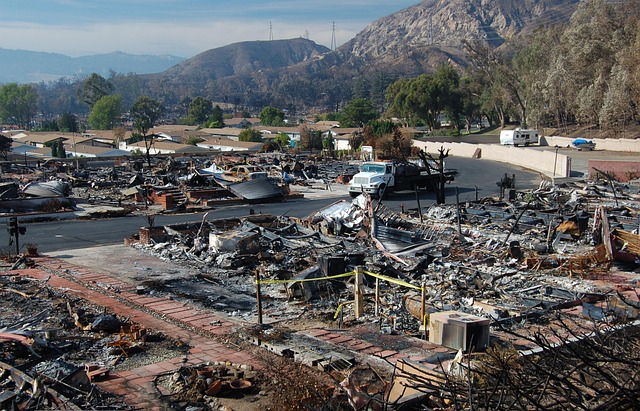Selling fire-damaged homes in California presents unique challenges, but specialized agents play a vital role in facilitating successful transactions. They navigate micro-markets from bustling cities like LA and San Francisco to rural areas, understanding post-disaster dynamics. These experts assess damage, guide insurance claims, ensure compliance with building codes, and connect homeowners with reliable contractors. Through strategic pricing, marketing, and negotiation, they transform fire scars into potential for rebirth, leveraging visual storytelling on platforms like Instagram and Facebook. Legal transparency and proper documentation are key to managing risks and ensuring fair compensation.
In California, where the real estate market is both diverse and competitive, understanding the unique dynamics of the state’s property landscape is crucial. This article delves into key aspects of navigating the sale of fire-damaged homes in this diverse environment. From appreciating the role of real estate agents specializing in such cases to exploring effective home staging and marketing strategies, we provide insights on legal considerations and insurance claims. Learn how to successfully sell your fire-damaged property in California.
- Understanding California's Real Estate Market: A Unique Perspective
- The Role of Real Estate Agents in Selling Fire-Damaged Properties
- Strategies for Effective Home Staging and Marketing in California
- Legal Considerations and Insurance Claims: Navigating the Process for Sellers
Understanding California's Real Estate Market: A Unique Perspective

California’s real estate market is a dynamic and diverse landscape, presenting unique challenges and opportunities for real estate agents. With a vast array of micro-markets across the state, from bustling metropolitan areas like Los Angeles and San Francisco to more rural and suburban regions, understanding local trends is key. This varies significantly when it comes to selling fire-damaged homes in California.
While natural disasters can pose unique hurdles—such as increased competition for rebuilds or potential insurance complications—they also create opportunities. Many buyers seek properties in areas that have recovered from fires, recognizing the potential for both rebuilding and community resilience. Agents who specialize in these situations must be well-versed in post-disaster markets, understanding how to navigate the emotional and practical aspects of buying and selling in such unique circumstances.
The Role of Real Estate Agents in Selling Fire-Damaged Properties

In the aftermath of a fire, real estate agents in California play a pivotal role in guiding homeowners through the complex process of selling their damaged properties. They bring invaluable expertise and market knowledge to help assess the extent of the damage and determine the best course of action, whether it’s a partial renovation or a complete rebuild. Agents are adept at navigating insurance claims, understanding local building codes, and connecting owners with reputable contractors—all essential steps in preparing fire-damaged homes for sale.
These professionals also possess strong marketing skills, crucial for showcasing the potential of a property that may have visible scars from the fire. They employ strategic pricing, compelling photography, and targeted advertising to attract buyers who recognize the value beneath the surface. Real estate agents are adept at negotiating with insurance companies, ensuring homeowners receive fair compensation while helping them understand their rights and options in selling their fire-damaged California residences.
Strategies for Effective Home Staging and Marketing in California

In the competitive California real estate market, effective home staging and marketing are key to attracting buyers and selling properties efficiently. When dealing with fire-damaged homes, a strategic approach becomes even more critical. Here’s how agents can navigate this unique challenge:
Agents should prioritize thorough restoration as the first step. Repairing structural damage, replacing burnt items, and restoring aesthetics are essential. Beyond physical repairs, focus on emphasizing the potential for rebirth; showcase how buyers can transform the space into their dream home. Utilize avant-garde staging techniques to present a fresh, modern look, appealing to diverse buyer preferences. Marketing strategies should include high-quality photography highlighting both the restored areas and unique features, as well as video tours that capture buyers’ imaginations. For selling fire-damaged homes in California, social media campaigns can be powerful tools, leveraging platforms like Instagram and Facebook to reach a broad audience with compelling visuals and narratives that tell the property’s story of resilience and renewal.
Legal Considerations and Insurance Claims: Navigating the Process for Sellers

When selling a fire-damaged home in California, understanding legal considerations and insurance claims is crucial for a smooth transition. Sellers must first assess any potential liabilities associated with the property’s history. If the home sustained significant damage from a fire, it’s essential to disclose this information transparently during the sale process to avoid future disputes.
Navigating insurance claims can be complex. Sellers should consult with their insurance providers and gather all necessary documentation related to the fire damage. This includes repair estimates, photos of the damage, and any reports from firefighters or structural engineers. Proper record-keeping is vital to support insurance claims and ensure fair compensation for any repairs required before selling the property.
In conclusion, real estate agents play a pivotal role in navigating the unique challenges of the California market, especially when dealing with fire-damaged properties. By understanding the local landscape and employing effective strategies for home staging, marketing, and legal navigation, agents can guide sellers through the complex process of selling fire-damaged homes in California. This comprehensive approach ensures a smoother transition and maximizes the potential for successful sales.






